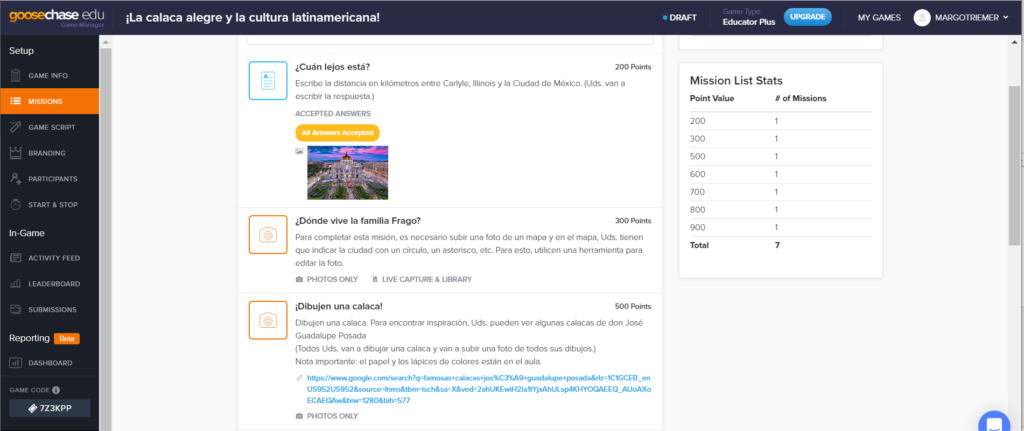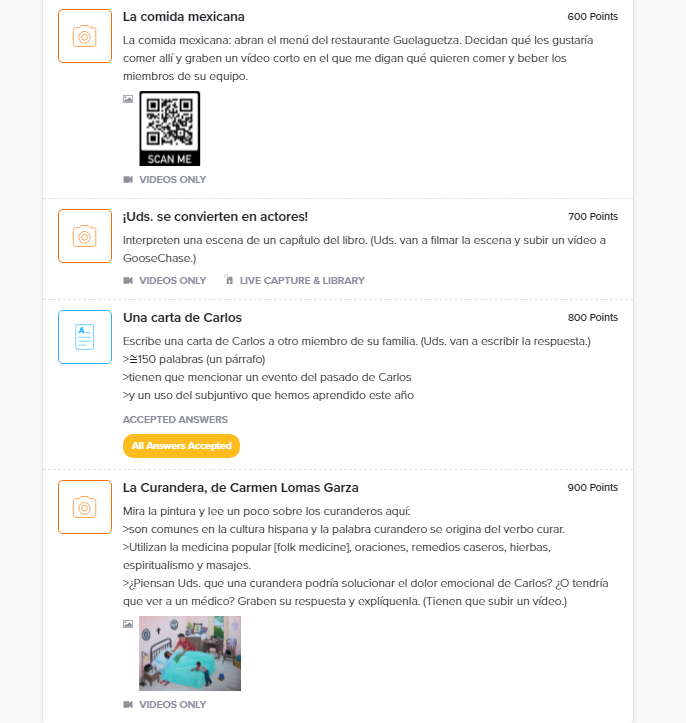Let’s play GooseChase!

Guest post by Margot Riemer, Spanish Teacher, Upper School World Languages, Harvard-Westlake School
When I reflect back on the astonishing experience of teaching for more than an entire school year on Zoom, I am surprised by how much I gained from it. One of its many benefits was that I allowed myself an extraordinary amount of freedom to experiment with new approaches to teaching Spanish. I made a concerted effort to liberate myself from my usual perfectionism so that I could try new methods and tools, keeping what worked well and jettisoning whatever did not. It was fun! This intellectual freedom is one of the unexpected benefits of the pandemic that I will try to keep present in my daily approach to planning.
When the school year ended, I enrolled in Post-Pandemic Language Teaching, a course offered by the Online Language Teaching (OLT) initiative at Michigan State University’s Center for Language Teaching Advancement (CeLTA). Taking this course at that time dovetailed perfectly with my newfound enthusiasm for experimentation and it was during this course that I decided to explore in depth a new discovery, the GooseChase app. I first learned about it from Beth O’Connor’s excellent article in the FLTMAG, and tried it out for the first time on our first day of the 2021-2022 school year. In the paragraphs that follow, I will discuss the value of Goosechase as a transformative tool (for teachers and students) and consider some potential obstacles to its successful implementation.
First, though, I should share a little bit about my educational context. I teach at Harvard-Westlake School, an independent, co-educational university preparatory day school. We have two campuses and 1,620 students enrolled in grades seven through twelve. I teach at the Upper School, where new or rising sophomores usually take level II or level III of their chosen language; after completing level III, they have completed their language requirement and can drop it for junior and senior year if they choose to do so. Though a majority of our students choose to continue their language study during junior and even senior year, we are always trying to encourage even higher numbers of students to stick with their language study through higher levels.
It is incumbent upon us teachers to be effective and to make the class enjoyable, stimulating, and interesting. This is why I am always on the lookout for tools, techniques and strategies that will engage my students’ interest and make them want to sign up for another year of language study at course signup time in the spring. GooseChase is one of those tools.
A brief description of GooseChase
GooseChase is an online platform that helps teachers create real-world scavenger hunts for students to play. Teachers can use the free version of the app; it is relatively easy to use and it allows the running of one live game at a time with a five-team limit, meaning that a class of 25-30 students can play without difficulty. Students can play in a physical classroom or virtually, and they can actually search for physical things, as they would in a traditional scavenger hunt, or they can upload “evidence” in the form of photos, videos, text or GPS coordinates.

Bringing GooseChase to the classroom
The decision of how to use GooseChase is probably limited only to a teacher’s imagination. I have used it once so far this academic year, on the first day of school (the missions were related to topics that students would presumably have learned in Spanish I). Students really enjoyed it: it afforded them a chance to meet and collaborate with their classmates; it got them out of the classroom (some missions required that they find a place on the campus); and it was a welcome change from hearing teacher after teacher discuss the course prospectus and grading system.
I intend to use GooseChase again after we finish reading the CI novel La Calaca Alegre as a way to review the novel and increase students’ comprehension of the plot. As O’Connor explains in the FLTMAG article, many teachers use GooseChase as an extension of topics studied in the classroom and as a way to review previously-learned material.
Writing thoughtful missions can take some time; however, once they are created, it only takes a few minutes to build the game. (This helpful tutorial takes teachers through each step of game creation.) Below are two screenshots of the missions I wrote for the Calaca Alegre game that I plan to play with students in the spring:
Once the missions are created, it’s advisable to try the game out with another teacher, or with a couple of student assistants. This is especially important on teachers’ first try with GooseChase, because it allows them to see what the game looks like from the students’ view, and it can make teachers aware of potential problems or obstacles.
The transformative aspect of GooseChase
What makes GooseChase unique is that it gamifies something that would otherwise be academic. We discuss a lot about our novel; we do practice quizzes; we look at murals connected with places mentioned in the novel; we reenact scenes at times. GooseChase is a way to take all that important academic work and recycle and repeat it in a way that feels organic, fun and exciting to students. The missions designed in my Calaca Alegre game engage students on many different levels: visual/spatial (in that there is a mission that involves a map); interpersonal and kinesthetic (they must reenact a scene themselves); artistic (one mission asks them to draw a calaca); and even mathematical (they have to measure distance at one point). All throughout the game, students are interpreting text or art and negotiating meaning with each other in Spanish. They are not limited to the classroom when doing so, but can still be monitored by the teacher who can view their uploaded evidence and comment on it and even amend the missions in real time.
Potential hurdles to anticipate
Teacher preparation: as with any new tool/activity/game, Goosechase requires a significant amount of work to set it all up so that students will feel (and be!) successful. As I indicated earlier, teachers must set up the game itself. Even though there are banks of missions to choose from, I find that copying other people’s work doesn’t usually save me time. I get good ideas from hunting around and seeing what others have done, but I always have to personalize the tasks to my students and classes. The last step is the trial run.
Encourage exclusive use of Spanish during the game: If teachers envision using GooseChase as an interpersonal grade, then students have to communicate with each other in Spanish in order for the exercise to be worthwhile. This is always difficult during games, because the students naturally default to English as they encourage each other, celebrate their successes, and experience frustration. I am not happy with my usual ways of trying to keep students on task in Spanish during games because I mostly end up micromanaging them, nagging them and reminding them that I’ll take points away if I hear English. Here are a some possible solutions:
- provide students with a list of phrases/words that they might need in order to be successful during the game;
- involve students in making a “use of Spanish only” agreement;
- offer a way to get points back if they lose any by using English;
Noise: Learning can be noisy, which is acceptable to me, but some other teachers in the same hallway may not find it acceptable, so this is something that teachers should take into account.
Potential obstacles notwithstanding, GooseChase is definitely worth the time and effort that it requires for successful implementation. But whether you decide to try it or investigate different tech tools is almost beside the point: what feels most important at this moment is to let go of the feeling that everything we do for our classes has to be vetted and done perfectly. It is so important to embrace change and creativity and simply to be open to trying new approaches to learning, especially after our lived experiences during quarantine. Ask yourself where you stand with technology integration and how remote teaching has the potential to lead your teaching into new areas of innovation!

